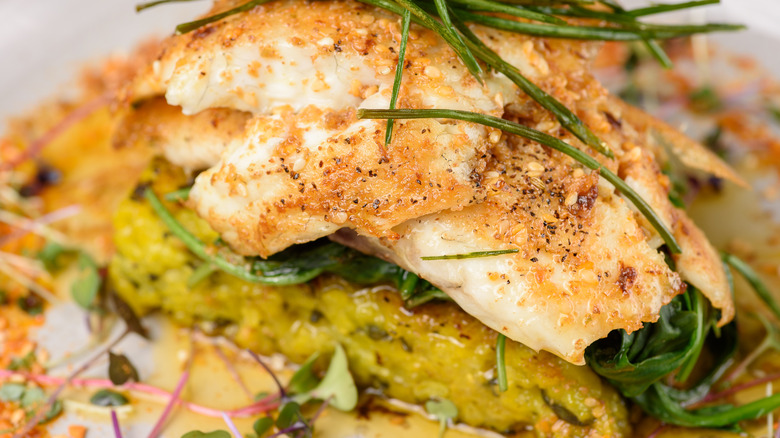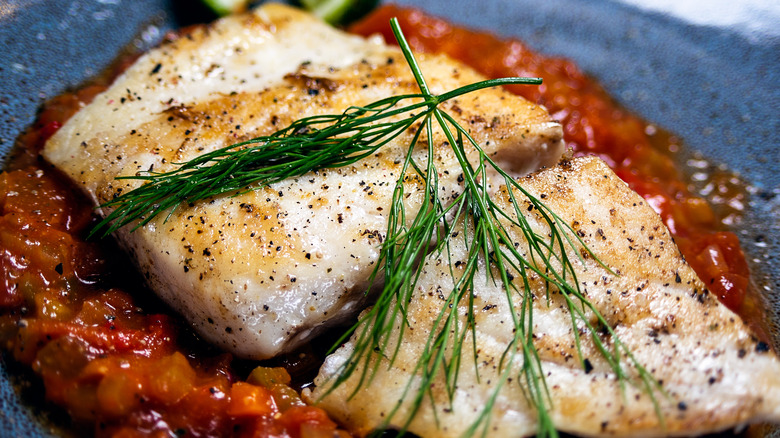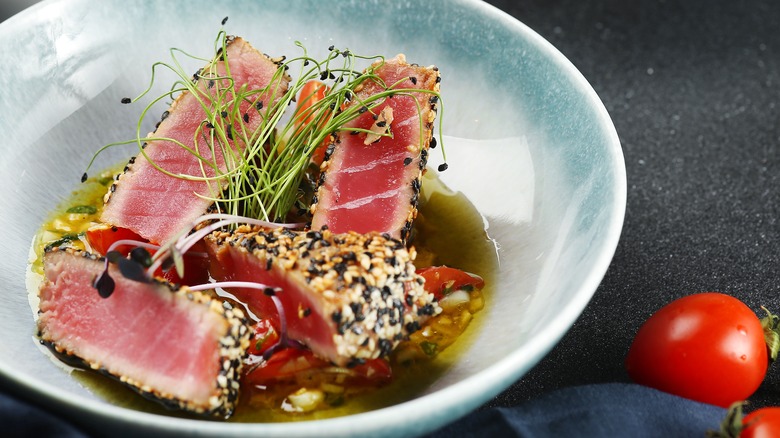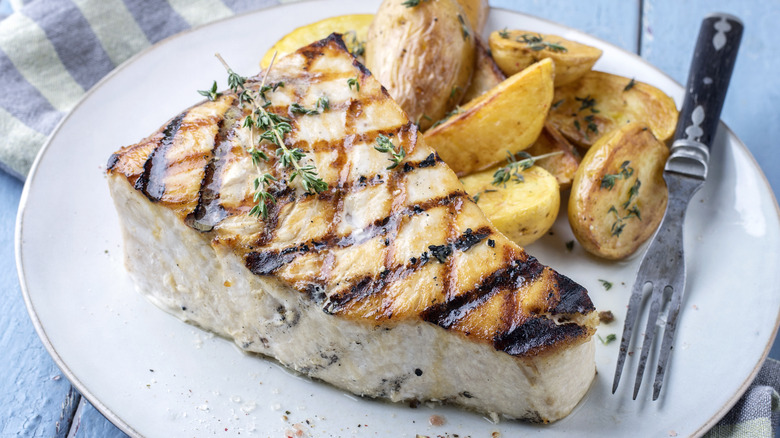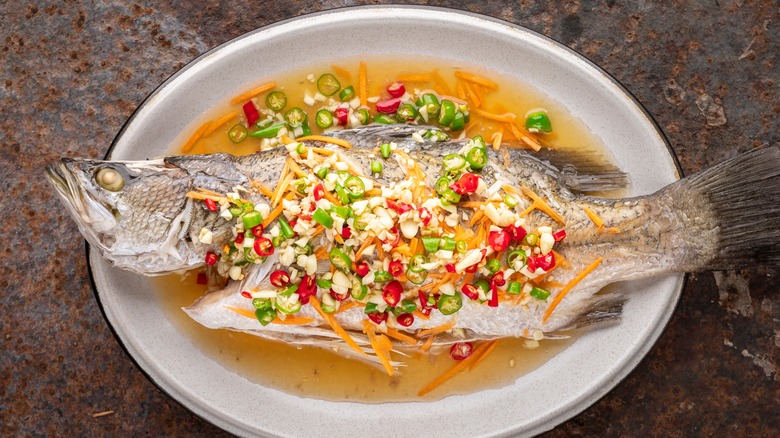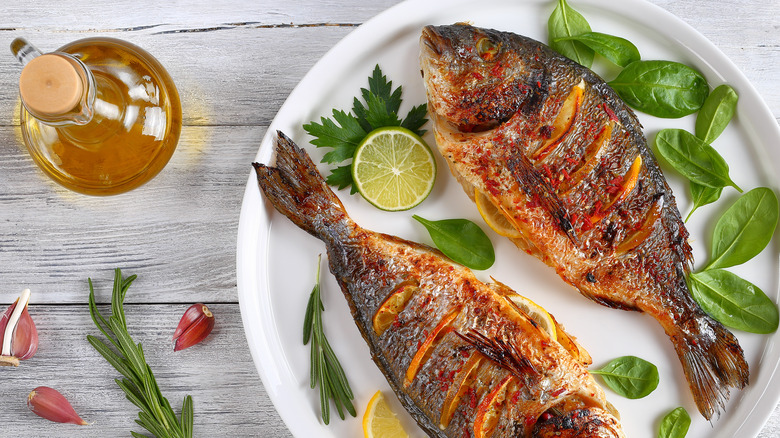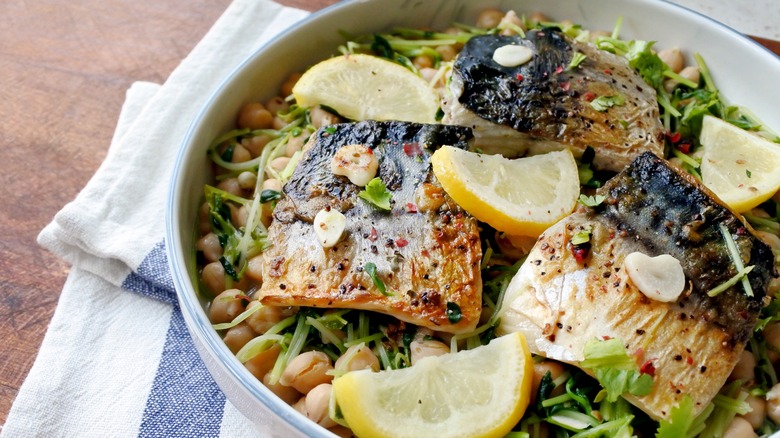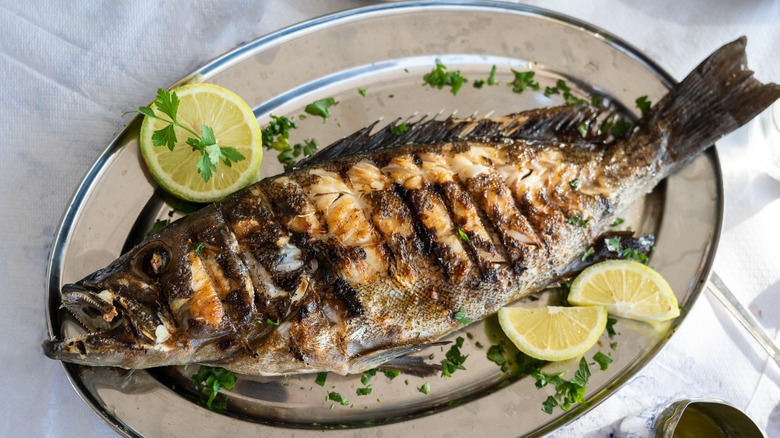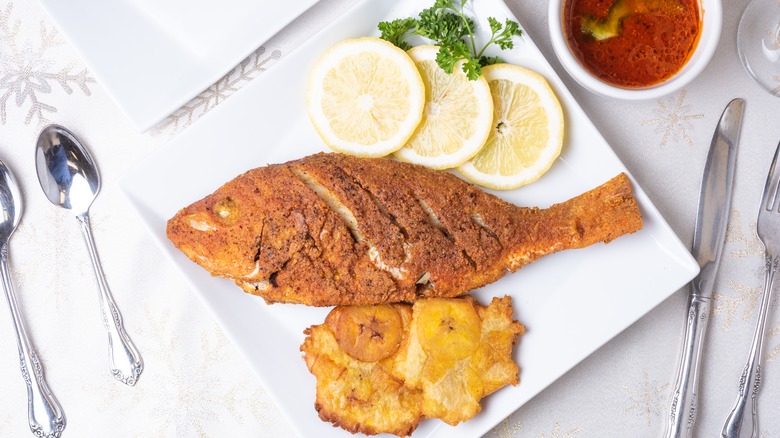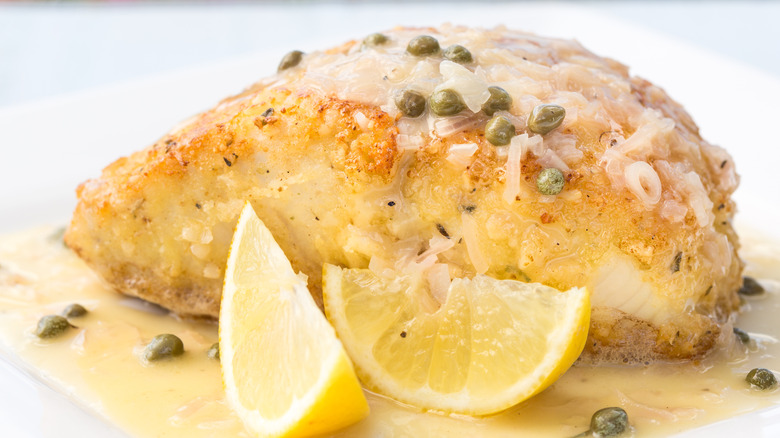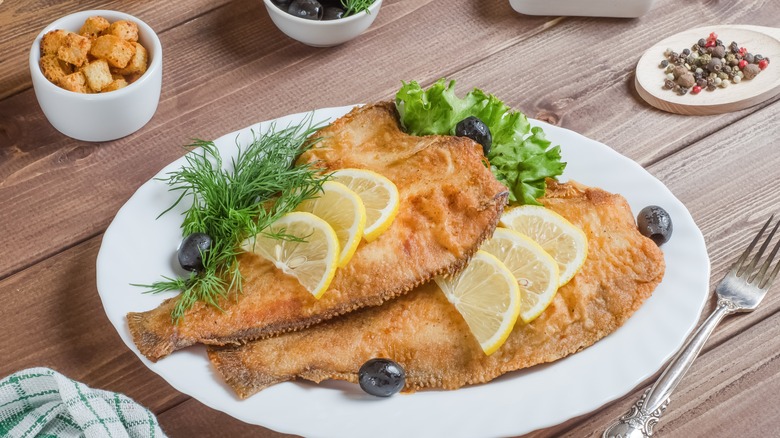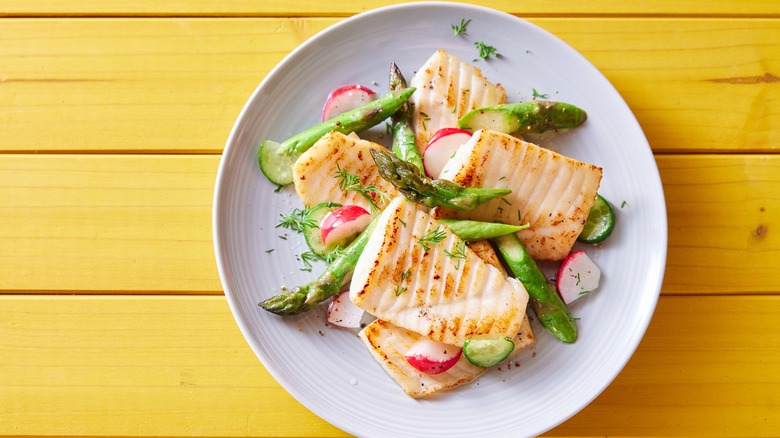11 Types Of Tropical Fish That Are Absolutely Delicious
If you're keeping up with the U.S. Food & Drug Administration (FDA) recommendations to consume at least 8 ounces of seafood per week, then you're probably having it on a couple of nights. It's easy to fall into a rut of eating the same grilled salmon dish or that shrimp pasta recipe that's delicious and quick to make. While it's comforting to have familiar favorites (not to mention simpler than trying to whip up a new dish every night), from a nutritional and culinary standpoint, variety is the key.
We're all for eating local, but sometimes tasting new items from far-off places is what you need to enhance your day. First and foremost, you'll want to ensure that whatever you're consuming is sustainably sourced — which is especially important with seafood. For example, an Ocean Wise stamp guarantees sustainable harvesting, which means there's a future in which we can continue enjoying delights from the sea. Additionally, looking for a blue label from the Marine Steward Council is also a good way to verify the environmental resiliency of your chosen fish.
Tropical fish live in warmer waters around the globe and are prized for the flavors and textures they bring to the table. Most are simple to cook and versatile to prepare so that you can accompany them with all sorts of side dishes. Why not pick up something new on your next trip to the fish store and imagine you're eating it on a sunny beach?
Mahi mahi
If you've been lucky enough to travel to Hawaii, then you've probably tried locally sourced mahi mahi. The majority of what you'll find sold in the U.S. comes from the surrounding Pacific ocean though some are fished in the Atlantic, Gulf of Mexico, or the Caribbean, according to the National Oceanic and Atmospheric Administration (NOAA) Fisheries. Consequently, mahi mahi is a more sustainable seafood option; it is a resilient species, and there are no worrisome figures regarding populations.
Now that you feel relaxed about eating them, the next factor is to take your mahi preparation in the kitchen. Although some fish are huge (up to 50 pounds!), most mahi mahi are around 5 pounds in size (via Seafoodsource). You'll want to remove the thick skin to reveal the lean pinkish meat beneath. When cooked, it becomes white, and the consistency remains moist and flaky, whether you pop it on the grill, fry, saute, or broil it.
For a fuss-free dinner, our easy-baked mahi mahi recipe is ready to eat in half an hour. Paired with a mango bell pepper salsa with a citrus cilantro dressing, you may as well be in Hawaii as far as this dish is concerned.
Tuna
Your first introduction to fish might have been in the form of a tuna salad sandwich. However, there's much more to tuna than the canned stuff. According to American Oceans, it's a major player in the fish industry, and it comes in various types. Blue, black, and yellowfin, as well as big eye, albacore, and skipjack (commonly used in cans), to name a few. Although you'll want to avoid bluefin tuna as it risks extinction, other commercial types are regulated from overfishing, making them a sustainable seafood option (via World Wildlife Fund).
You're bound to come across yellowfin and big eye tuna in fish stores, often labeled as ahi. Sold as steaks, these tropical fish are a far cry from tuna salad. Your primary concern when cooking tuna should be to avoid drying them out. For best results, you'll want to sear each side for around one minute on high heat. The center will remain pink, but that's what distinguishes it from ordinary skipjack in a can. It also gives each bite a delightful melt-in-your-mouth consistency that's unparalleled. Be sure to season the tuna to infuse it with plenty of flavors; it works well with a blackened spice rub, or try a sesame-crusted tuna steak with soy sauce for the ultimate feast.
Swordfish
A full swordfish is an impressive sight, aptly named for its long pointy bill. While we certainly wouldn't want to have one behind us in the water, finding one in front of us on a plate is a different story. Apart from the worrisome swords, these fish can be fairly oversize; we're talking over 10 feet long (and up to 15) and occasionally weighing 650 pounds, as Oceana reports.
Given the large dimensions, the outlet notes that swordfish tend to contain higher mercury concentrations within its muscle tissue. You'll want to avoid consuming it more than once a week to ensure you are within the limits of safe toxin levels, or perhaps even reconsider it if you deem the amounts unacceptable. As for sustainability, Greenpeace claims that the most reliable sources for swordfish are in the waters around California, Oregon, and Hawaii.
Much like tuna, swordfish is often sold in a steak cut. Consequently, pan frying or grilling are great options thanks to the hearty consistency. Our grilled swordfish recipe brings out the briny flavors with lemon, garlic, and thyme marinade. Mediterranean flavors work well with this versatile fish, so don't hesitate to experiment. Since the steaks are often thick, grill the fish for a few minutes on each side until the center is white and flaky but still juicy. This isn't a fish you want to eat half done, or else the texture will be unpleasant and rubbery.
Barramundi
In the eyes of The Better Fish, barramundi deserves the title of the "it" fish. This Australian and Indo-Pacific fish might not be common in the U.S., but it's just a matter of time. A notable accomplishment in an industry plagued with overfishing, barramundi can be sustainably farmed without resorting to antibiotics or hormones to boost its population.
Not to mention, barramundi (also called Asian sea bass) is delicious and easy to prepare, whether you fry, grill, bake, barbecue, or steam it. If you're the kind of person who airs out their kitchen after a salmon dinner, you'll be glad to know that the scent is mild and won't linger. Its meaty texture holds up to plenty of cooking methods, and its subtle flavor makes it suitable for seafood novices and anyone keen to try out new ingredients.
Try tossing it in a marinade or pairing it with a flavor-packed side. Meanwhile, an easy grilled barramundi recipe lends itself well to lemon and herb seasoning, and salty Asian sauces make another great match. Unlike certain fish, cooking the whole thing isn't a difficult feat; cover it in a lemon butter sauce with capers and bake it until the center is firm and white.
Sea Bream
The more you dig deep into the world of fish, the more you realize how many species have the same names. Not all sea bream live in tropical waters, and a number of them are found in the Mediterranean and throughout Europe (via Seapedia). These fish are typically flat and consist of lightly flaky, meaty white flesh. The flavor is fairly neutral, which makes sea bream an excellent canvas for other ingredients, though you'll want to avoid overpowering the subtly sweet taste.
Commonly grilled whole, baked, steamed, or fried, sea bream is prized on menus worldwide. Famed chef Gordon Ramsay opts for a salt crust, which guarantees flavor and prevents the delicate fish from drying out as it bakes. Follow his directions and stuff the whole fish with lemon slices, then lay it on a bed of salt and cover it with yet more salt. After you unearth it from its crusty salt shell, serve the baked sea bream with braised leeks and hazelnuts or your choice of side for an impressive presentation worthy of a fine dining restaurant.
Mackerel
Mackerel is an obvious contender if you're a fan of oily fish. Its oily consistency is also responsible for its health benefits, including its praiseworthy levels of omega-3 fatty acids (via Great British Chefs). Among the various types, cero mackerel are commonly found in coral reefs in the warm waters around Florida and the Gulf of Mexico (via Florida Fish and Wildlife Conservation Commission).
It's certainly a flavor-forward fish, so if you're not one for stronger tastes, or want your side dish or sauce to stand out instead, you might want to skip over this option. That being said, mackerel can be prepared in plenty of ways, so you might find one you enjoy. Grilling, baking, frying, and pickling are some methods, and it is also commonly used in pâtés, fishcakes, burgers, or appreciated raw sashimi style. Thanks to its high-fat content, you can even smoke mackerel without worrying about drying it out.
Grouper
According to the Florida Department of Agriculture and Consumer Services (FDACS), grouper is always on the menu in the Sunshine State. Red grouper is one of the more common types fished locally, and it maintains acceptable levels of harvesting, which makes it a sustainable choice, per NOAA Fisheries.
Whether you make a trip to Florida or simply pick up this tasty fish at your local fishmonger, you'll be satisfied with this member of the seabass family. Before going out to shop, it's worth noting that the FDACS warns consumers that less reputable vendors sometimes swap grouper for cheaper fish as it skews toward the pricier end of the spectrum. If the deal seems too good to be true, it's probably not grouper.
The delicate flavor, lean meat, and flaky consistency are easy to appreciate, and it wouldn't be out of line to compare it with chicken. Finn's Fishing Tips sites grouper as swimming between halibut and bass in terms of flavor. You can do a lot with grouper in the kitchen, like pan-frying, grilling, poaching, sauteing, baking, and steaming it. It's also commonly breaded and fried for a tasty fish sandwich, burger, or fish and chips combo. Grouper cooks fast, so keep a close eye and remove it from the heat once the flesh is opaque and flaky.
Snapper
Britannica reports that there are over 100 types of snapper, which makes it a bit tricky to know exactly what you're dealing with when you come across this common fish. Many live in warm tropical waters and are a staple part of local diets. Red snappers are a prime example, named for its distinct pinkish-red skin and found in the Caribbean and the Gulf of Mexico (via Tastylicious).
Fish sold in the U.S. typically come from these sources, but it's important to note that there are some variations as to the sustainability of the harvesting methods, and it has been overfished in the past, as Fish Choice points out. Meanwhile, if you're shopping on the West Coast, the outlet indicates another case of fish fraud is rampant; rockfish often masquerading as Pacific red snapper.
It's an easy fish to love thanks to its delicately sweet flavor, minimal fattiness, and moist consistency. A red snapper is a solid option if you like eating fish that doesn't display overtly fishy flavors front and center. It lends itself well to being cooked whole, or you can purchase fillets for easy preparation. Try a panko-crusted red snapper recipe for a delicious weeknight dinner that's on the table in 20 minutes. Or enjoy the unadulterated flavors of the fish with a simple snapper crudo.
Wahoo
Whether you call it by its festive-sounding name wahoo or opt for its Hawaiian title ono, this is a delicious fish. In fact, ono means "good to eat" (per Hawaii Seafood) so it's off to a good start. Followed by its respectable sustainability status as determined by NOAA Fisheries, wahoo is an all-around good decision. You won't be able to find fresh ono year-round though; peak harvest season in the Pacific is from summer to fall. Given its superior mercury content, it's recommended to limit your consumption in any case (via Environmental Defense Fund).
In the kitchen, it's important to note that wahoo is a very lean fish. While this translates to a pleasantly mild flavor that welcomes other seasonings, it also means that it risks drying out if it's overcooked. Take our word for it, you don't want to eat dry wahoo. Quickly grilled, broiled, poached, or pan-fried, the result is moist and flaky. Seafood Source compares it to tuna (both the cooking process and flavor profile) and suggests using a marinade to season it. Classic lemon or an Asian ginger soy dressing are some tasty options.
Flounder
As it turns out, flounder consists of a large group of flatfish (named for appearance), including fluke and sole (via Food Network). National Geographic reports that a large number of species choose warm tropical waters as habitats. Thankfully, most face little to no issues of overfishing and are considered a sustainable dining option, according to the International Union for Conservation of Nature's Red List.
These funny-looking fish (the two eyes are located on the same side of their head!) have tender, mildly sweet flesh that requires a bit of gentle handling in the kitchen. Purchase it whole or in fillets depending on your comfort level, and prepare it either in the oven, steamed, or sauteed. To make it less fragile, a light breading or flour coating prior to cooking should produce successful results. Play up its delicate flavor and lean consistency by finishing it with lemon butter sauce.
Tilapia
If a number of these tropical fish were completely unknown to you, chances are you've come across tilapia before — at least by name. Indeed, in 2019 it was the fifth most commonly consumed fish in the country at just under a pound per person, according to a report by the National Fisheries Institute (via Seafood Source). Tilapia is also a sustainable option since it can be easily and affordably farmed, minimizing the strain of overfishing (via Food Print). Actually, the greater worry is the fact that tilapia breeds at high rates, causing it to be invasive in certain regions of the world and earning it a spot in the Global Invasive Species Database. Basically, you're doing a good deed by eating it.
This brings us to the question of how best to eat it. As an ordinary white fish, there's a lot you can do with tilapia. The Food Network recommends buying whole fish to avoid compromising quality and consistency. Try baking, grilling, pan-frying, sauteeing, or steaming the flaky fish, and be sure to discard the skin, which has an unpleasant flavor. Since this fish has such a neutral taste, try enhancing it with a flavor-packed seasoning such as in our Parmesan-crusted tilapia recipe.
